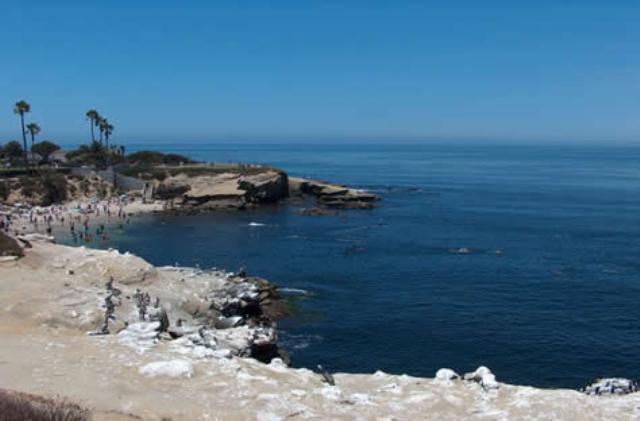La Jolla Cove Snorkeling: Too Chilly to 'Skin it?'


It is only natural for most outdoor activities in San Diego to revolve around the Pacific Ocean, with its peacock blue, aqua green, turquoise, and pearl foam hues. These ambient colors make for decent visibility on top of, or underneath the photo tropic layer layer of water. In La Jolla, the La Jolla Cove, part of the La Jolla Ecological Reserve, is a main attraction for all water enthusiasts. Snorkeling, scuba diving, kayaking, paddle boarding, or simply watching seals sunbathe are a favored pastime in this area. Although summer has unfortunately come to an end, one can still suit up and hop in the water.
Maneuvering down La Jolla Shores Boulevard, the westward beaches start dwindling into a rockier coastline near the beginning of the cove. The smell of sea life becomes much more pungent, houses more expensive, and stunning vistas cause one to drive slower. The fact of the matter is that typically during the weekend the cove sees throngs of families, tourists, locals, shoppers, and mass congestion - so finding parking is also of some concern.
If one plans on snorkeling, the beauty of it is that it is free, granted you have a mask, fins, and a wetsuit. With water temperatures dropping from the low 70s to mid 60s, a 3.2mm wetsuit/spring suit is recommended, as your body will be underwater nearly the entire outing (or 'skin it'). Don't have a mask? Fins? This should not pose a problem as San Diego Bike and Kayak Tours rents out gear. The main entrance to La Jolla Cove is bustling with activity; seals are perched up, jockeying for a position on the rocks, families are pick-nicking, and divers are checking their equipment. Pods of marine mammals buoyantly balance on their backs in the shallows.
To gain access to the more interesting areas of the cove, walk down to the public beach, put on your fins and mask, and backstroke through the initial sea grass. After about forty to fifty yards, snorkel up and get your heart rate comfortable. The sea grass isn't as thick, and the water depth transitions from four feet to ten to twenty feet at some points. Schools of Garibaldi, California's neon orange state fish, as well as yellow fin, rock fish, live kelp beds and seasonal leopard sharks become your new acquaintances. The leopard sharks are docile, and are only around predominantly during breeding season in the summer. All of this aquatic activity, from mammals and fishes alike, is relaxing and primal all the while.
The current is obviously tougher on windier days, and you can begin to notice the similarities between the Garibaldi's range of motion and your own. Take a couple brief, shallow dives to manipulate the undercurrent, snorkel mouthpiece out or in (personal preference) to ease the strain of fighting the current on the top layer of the water. Be sure to make sure that your group is relatively close, as it is easy to get distracted and end up spinning your head around like a seal.
On sunny days, the seals are in groups in the warmer spots of the water: barking, sunbathing, bellies up and flippers flopping about. A bit alarming at first, the seemingly sluggish looking creatures while on land are amazingly graceful and curious while under the water. The mammals are quick swimmers, able to barrel-roll their bodies while performing large circles around your group. Docile as well, one can typically get face to face, simply a few feet away, from a creature that resembles man's best friend. Don't try to feed them (why bring bait?), or get too close for comfort, as seals can bite you, though rarely attack.
San Diego, compared to other areas of the coastal United States, has decent water visibility year round. On some days, one could argue against that statement, but the fact that one can get so close to wild animals in their untamed element is a testament to the prior. To check water visibility on a given day click here.



